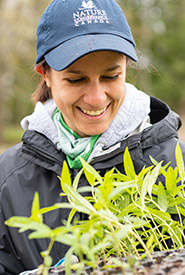Gotta catch 'em all? Count me in!
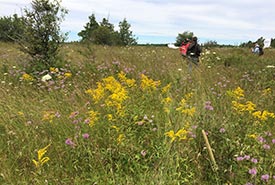
Carden Alvar butterfly count, 2017 (Photo by NCC)
As part of the 2019 Carden Alvar Butterfly Count, we were armed with a few nets and catching jars as our mighty group of eight, comprised of Nature Conservancy of Canada (NCC) staff and conservation volunteers, set out on a mission: to identify and count as many butterflies as possible over the course of the one-day event within our assigned circle on a map of Carden, Ontario. NCC and partners have been surveying dragonflies and butterflies for more than 20 years. Especially with climate change in the air, these collaborative efforts between NCC, partners and volunteers helps keep track of the health of dragonfly and butterfly populations on Carden Alvar.
Since 1997, NCC has partnered with expert local naturalist Bob Bowles, the Couchiching Conservancy, the North American Butterfly Association (NABA) and many volunteer experts to conduct dragonfly and butterfly surveys in Carden.
Bob, founding president of the Carden Field Naturalists and the eastern Canada coordinator for NABA, launched the surveys over 20 years ago, with groups as small as 10 participants. Since then, the surveys have become quite popular Conservation Volunteers events run in partnership with NCC, filling up each year with about 25 to 30 participants. These annual surveys are excellent learning experiences for budding dragonfly and butterfly naturalists and experts alike. These surveys have also allowed us to become familiar with the expected species on the landscape, so that we can have a sense of annual butterfly and dragonfly population health and trends.
Related content:
Why are we on Carden Alvar?
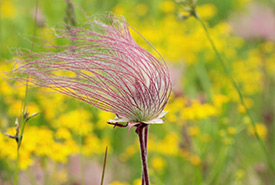
Prairie smoke, Camden Alvar East, ON (Photo by NCC)
“What makes Carden Alvar so special?” you might ask. I would recommend visiting the area to see for yourself, once NCC properties open to the public again. In my opinion, the beauty and uniqueness of the alvar landscape is beyond words. Picture big-sky country and a wide-open plain. You can traverse across mossy limestone, among unique grasses, sedges and wildflowers, like blue-eyed grass, prairie smoke and hairy beard-tongue, scattered among luscious shrubs of juniper and fragrant sumac. And you can see for miles, perhaps even hearing or spotting the nationally endangered loggerhead shrike, provincially endangered bobolink or one of the several other rare bird species found here.
Alvars are globally imperiled ecosystems, according to the International Union for Conservation of Nature, occurring only in Sweden and around the Great Lakes basin. The alvars in Carden are considered some of the most species-rich, high-quality alvars in the world. In Carden, you can find over 230 species of birds, 450 plants and 140 dragonflies and butterflies, and many are only found in the area.
As a result, Carden’s significant alvars are important ecosystems to conserve. NCC, along with our partners, has helped protect over 3,600 hectares (8,895 acres) in Carden Alvar since 1998. NCC has helped steward these lands through activities such as species surveys, like these butterfly and dragonfly surveys, and by limiting access to off-road vehicles and controlling invasive species. For example, thanks to a concerted effort that began in 2012, known locations of invasive dog-strangling vine have markedly decreased from dense monocultures to scattered individuals, and native plants are returning to the alvar. These activities have drastically improved the alvar ecosystem that supports habitat for several species.
Now trending: what are the counts on Carden Alvar showing over time?
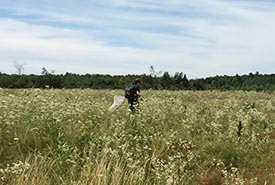
NCC staff with a butterfly net at the Carden Alvar butterfly count (Photo by NCC)
So, we have about 20 years of survey data for dragonflies and butterflies in Carden. What now? After some analysis, we found that both the numbers of individuals and species of dragonflies were increasing over time, while the number of butterflies was decreasing. There was an average of 44 butterfly species and 40 dragonfly species recorded per annual survey. Some of these results were a little surprising. We expected numbers to increase over the years because of more participants, warmer survey dates and improved organization of the project over time. Although this was observed with the dragonflies, butterflies were showing the opposite trend.
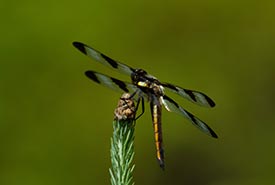
Dragonfly at Carden Alvar, ON (Photo by NCC)
So, what’s going on? It’s possible that the landscape is influencing patterns that we observe in wildlife behaviour and populations. An interesting next step for investigation could be to look at changes in land cover across the Carden Alvar over time.
These counts bring an amazing group of scientists, naturalists and volunteers together. They make for an exciting learning experience, and they provide a great opportunity to explore Carden’s unique alvars. Most importantly, they give us a chance to keep an eye on dragonflies and butterflies in Carden to ensure that their populations remain healthy long into the future. They also bring our attention to negative trends in time to respond to them where we can.
Speaking from personal experience, getting to know Ontario butterfly species during our survey and seeing the smiles on the faces of every participant easily show how the counts are indeed a win-win for important insects and investigators alike!

